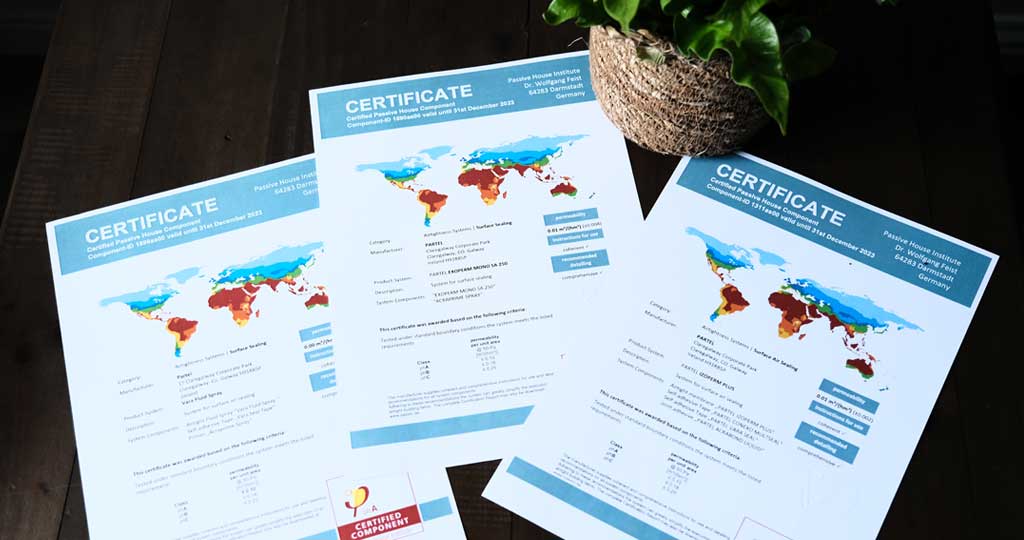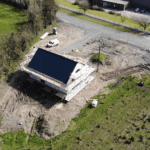An airtight membrane is one of the most critical components in any passive house or other high-performance building. It helps to prevent heat loss and draughts, and to protect the building structure from internal moisture. Partel supply a range of airtight and wind-tight membranes, including three systems that are certified by the Passive House Institute (PHI) in the highest component class, Class phA.
But why are high quality membranes so critical in a passive house, and how exactly are they tested by the PHI to ensure their quality?
Read on to learn about the critical role that Partel membranes play in high performance buildings, and about how they are tested and certified.
Passive house: an international standard
Passive House, or passivhaus, is a rigorous global standard for energy efficient buildings. The standard was initially devised for residential buildings in Central Europe, but it now applies to all types of buildings, all over the world. Buildings that meet the passive house criteria for extremely low energy demand for heating and cooling can be certified by the PHI. There are passive-certified buildings in climates ranging from the Swedish sub-arctic to the Brazilian tropics.
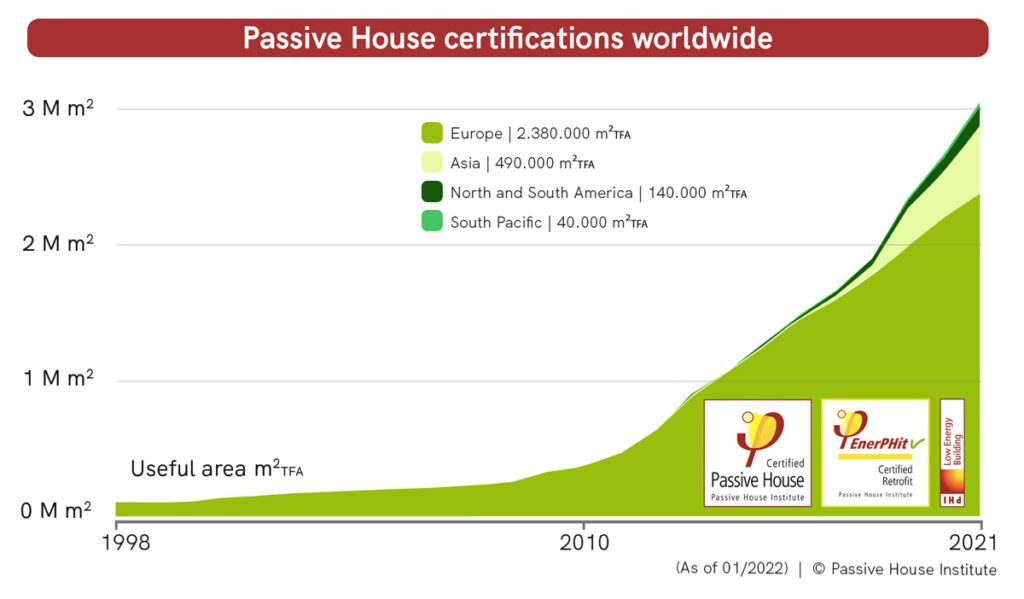
What is passive house?
Any building that meets the Passive House Standard can be called a passive ‘house’, regardless of whether it is a dwelling or not. In simple terms, a passive house is a building that is so well insulated and draught-proofed that it can maintain a comfortable indoor temperature of 20C primarily by passive means — from sunlight coming in the windows, from the body heat of building occupants, and from the energy given off by appliances.
Technically speaking, the PHI defines a passive house as, “a building, for which thermal comfort (ISO 7730) can be achieved solely by post-heating or post-cooling of the fresh air mass, which is required to achieve sufficient indoor air quality conditions – without the need for additional recirculation of air.”
This means that just heating or cooling the air used to ventilate the building can be enough to keep it comfortable inside. Generally, passive houses must have a maximum space heating and cooling demand of 15 kWh/m2/yr.
This is achieved through a number of factors: a super-insulated and thermal-bridge-free building envelope, rigorous levels of airtightness, highly insulated windows, and a ventilation system that consistently supplies fresh air without creating unpleasant drafts. The PHI certifies both new build (passive house standard) and retrofit projects (EnerPHit standard).
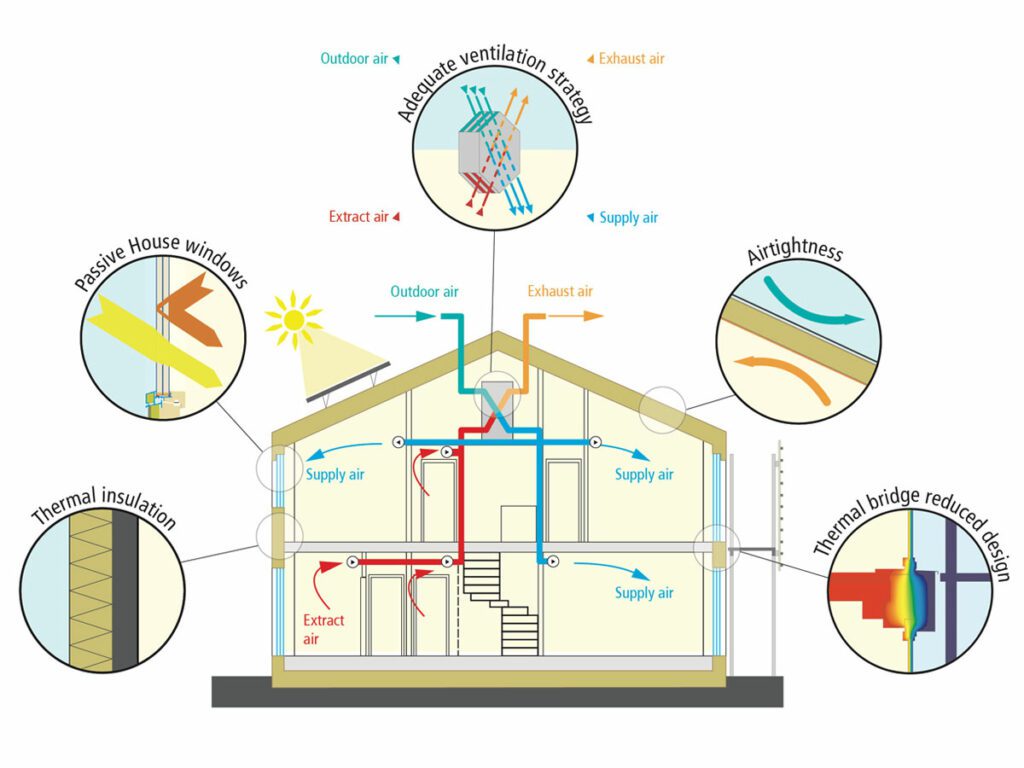
The purpose of airtightness in a passive house
Airtightness is critical to the performance of passive houses. An airtight building envelope has very low air permeability — in the case of the passive house standard, less than 0.6 air changes per hour at 50 Pascals of pressure. This essentially means that the building is highly draught-proofed.
People sometimes associate airtightness with a lack of fresh air, but in reality, the Passive House Standard requires an airtight building envelope AND a steady supply of fresh air through mechanical ventilation.
Airtightness is critical in high performance buildings for a variety of reasons:
- It prevents draughts and the associated discomfort.
- It stops heat leaking out of the building.
- It reduces noise infiltration.
- And most importantly, it prevents damage that can be caused when damp air is allowed to move into building structure.
The purpose of wind-tightness in a passive house
Wind-tightness is similar to airtightness, but refers specifically to external protection of the building structure from wind and rain. Wind-tight membranes are common in timber construction and are installed on the outside of the build-up (while airtight vapour control membranes are typically installed on the inside of the build-up in the UK and Irish climate).
Wind-tight membranes are vital for the proper functioning of insulation, because ingress of cold air or moisture into the insulation layer can damage its performance. They are also called breather membranes, because a good wind-tight membrane should be sufficiently vapour-permeable to allow any water vapour that gets into the building structure to escape to the outside (thus they are waterproof from the outside, but vapour permeable from the inside).
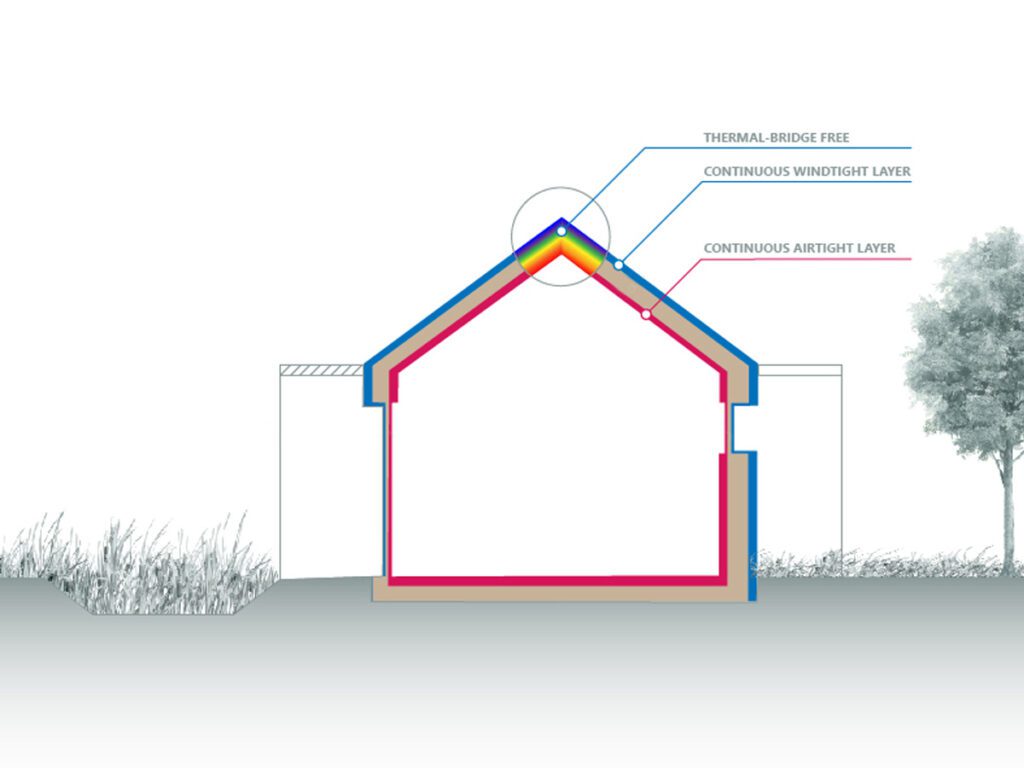
What are passive house components?
Meeting the passive house standard requires detailed design, rigorous attention to detail on site, as well as high-quality building components. Components such as super-insulated windows, airtight membranes and heat recovery ventilation systems must meet the highest energy efficiency standards to be deemed passive house suitable components. The PHI certifies a number of component types that are critical for achieving the passive house standard. These include:
Building envelope
Construction systems
Floor slabs
Airtightness systems
Thermal breaks including balcony connectors, façade anchors, and column & wall connections
Windows & doors
Building services
Heat pumps
Ventilation systems
Drain water heat recovery units
Why should products be passive house certified?
The PHI certifies products that are tested and deemed to meet the performance level required for use in passive buildings. PHI component certification makes it easier for building designers and specifiers to find suitable products when they are building to the passive house standard. This provides certainty that critical components will perform to the highest standard. It also means that the product is placed on the PHI certified components database.
PHI testing is completely independent, and manufacturers have no influence over the result. When conducting a test, the institute carefully follows all of the manufacturer’s installation instructions. This means that installation instructions must be well thought out and easy to follow for a product to achieve certification. Airtightness testing of membranes is designed to replicate on site installation — it tests how well the membrane works with other building fabric components as a whole system, rather than just testing the membrane by itself.
What are the criteria for passive house component certification?
The PHI sets certification criteria for the various product types mentioned above. For the purposes of testing airtightness systems, products are placed in one of three categories — surface sealing systems, penetration sealing systems, or airtight window connections.
In this blog post, we will look at how three Partel surface sealing membrane systems were tested and certified.
- IZOPERM PLUS is an airtight vapour control membrane for use on the warm side of insulation for walls, roofs and floors.
- EXOPERM MONO SA 250 is a wind and airtight breather membrane that is designed to protect the building structure from driving rain and moisture, while letting water vapour out of the building.
- VARA FLUID is a water-based liquid air and vapour control layer that can be either spray or brush applied.
All airtightness systems are classified by the PHI in one of three classes, A, B, or C, depending on how well they perform in laboratory testing.
| Certification Class | Air Permeability Per Unit Area |
|---|---|
| phA | ≤ 0.10 m3/hr/m2 |
| phB | ≤ 0.18 m3/hr/m2 |
| phC | ≤ 0.25 m3/hr/m2 |
The performance of surface sealing membranes like IZOPERM PLUS, EXOPERM MONO SA 250 and VARA FLUID is primarily tested by measuring the airtightness of their connection with adjacent materials. These joints are the most likely point of weakness in any assembly.
Three principal connections are tested:
- The material connected to a similar surface or another airtight membrane.
- The material connected with airtight composite woodboard (eg OSB).
- The material connected with a concrete / plastered surface.
How were Partel membranes tested?
The three Partel membrane systems were all tested by the PHI in a similar fashion.
IZOPERM PLUS
The IZOPERM PLUS membrane was cut into two metre pieces which were clamped into the test apparatus. To test the air permeability of two overlapping pieces of membrane, these were placed adjacent to each other, overlapping by 10cm, and then Partel’s CONEXO airtight tape was used to seal them together. The application of the tape took place with the membrane suspended in the air so that only limited pressure could be applied, so as to replicate site conditions as accurately as possible. For the other connections, an OSB panel or concrete slab was placed in a fixture provided in the test apparatus. IZOPERM PLUS was then taped to these panels using VARA SEAL tape (for the OSB panel) or ACRABOND tape (for the concrete panel). The membranes were again taped while suspended in the air.
Membrane to Concrete
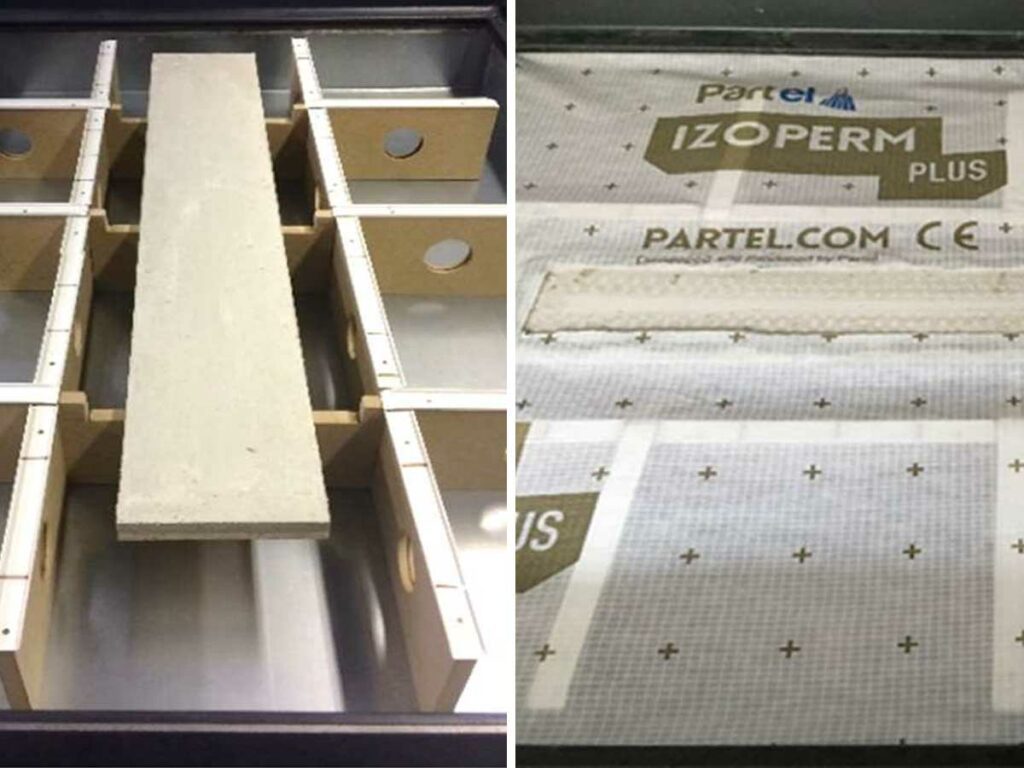
Membrane to OSB
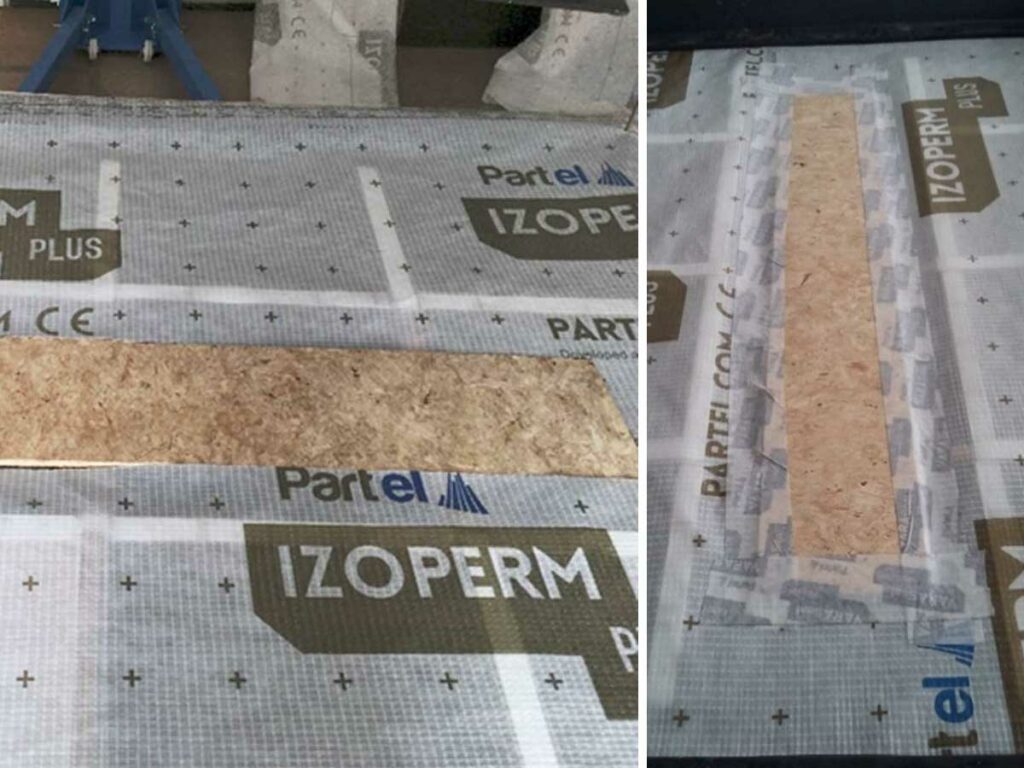
EXOPERM MONO SA 250
The self-adhesive EXPOERM MONO SA 250 breather membrane was applied to an air-permeable glass-fibre substrate. To test the connection between two pieces of membrane, these were sealed together, overlapping by 10cm, with firm pressure using a roller. To test the other connections, the OSB panel and concrete slab were placed in the fixture provided in the test apparatus. No primer was needed for the OSB, but ACRAPRIME SPRAY was applied to the concrete slab. EXOPERM MONO SA 250 was sealed to each of these panels using a roller, and left to cure for 24 hours.
Membrane to Concrete
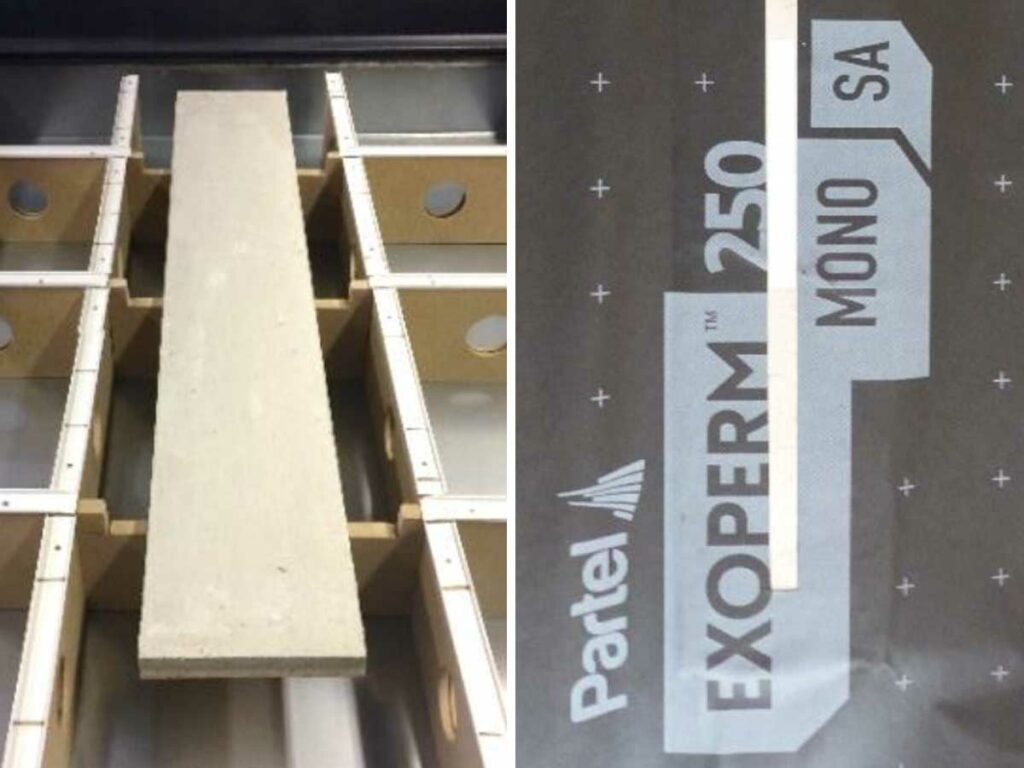
Membrane to OSB
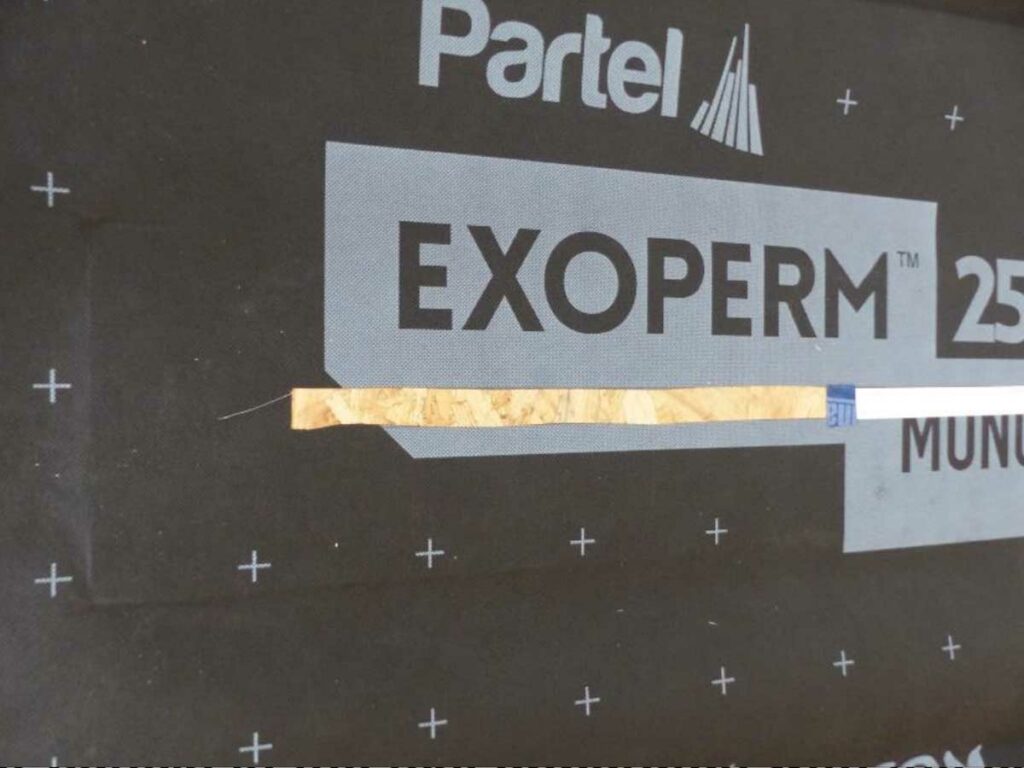
VARA FLUID
The airtightness of VARA FLUID was tested by measuring the air permeability of its connection with three materials: a certified membrane, OSB and concrete. These were each placed in a fixture in an air permeable glass fibre substrate. Each of these materials was taped to the glass fibre substrate with VARA SEAL tape, using a roller with heavy pressure to achieve a full bond. These connections and the surrounding surface of the substrate was then sprayed over with VARA FLUID.
All of the above assemblies were tested at 50, 100, 150, 200, 250, 300 and 350 Pascals of both positive and negative pressure. The leakage at each pressure level was measured, and the residual leakage of the test apparatus, which was measured separately, was subtracted from the results. The leakage flow at the reference pressure of 50 Pa was determined as an average value of the results from all the positive and negative measurements. The result was divided by the relevant sample area to find the leakage flow per square metre.
Membrane to Concrete
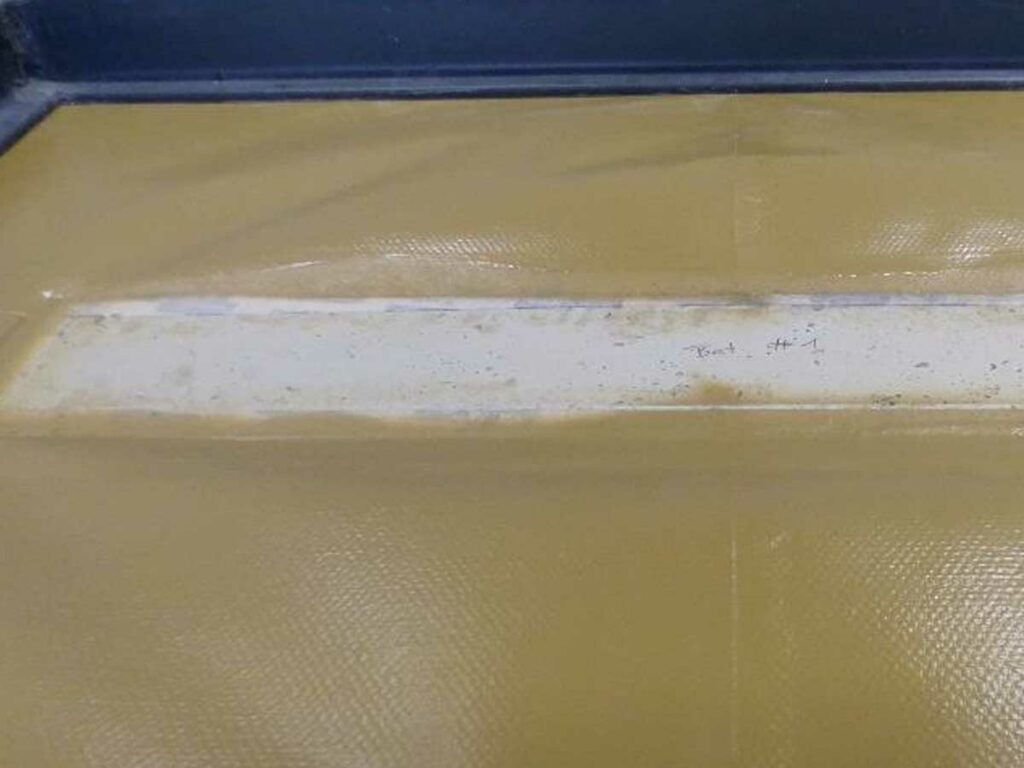
Membrane to OSB
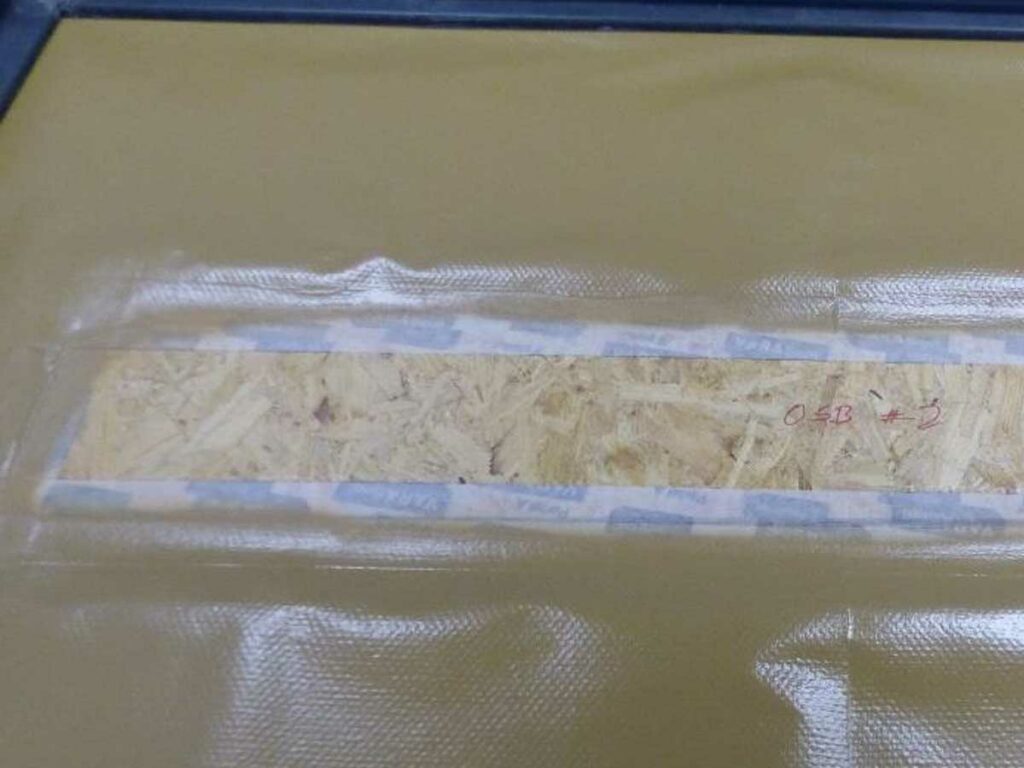
How did Partel membranes perform?
All three Partel membranes achieved phA, the highest class of component certification.
IZOPERM PLUS test results
| Average value of | m³/(hm²) @ 50 Pa |
|---|---|
| Membrane to membrane | 0.02 m3/hr/m2 (Class A) |
| Membrane to OSB | 0.01 m3/hr/m2 (Class A) |
| Membrane to concrete | 0.01 m3/hr/m2 (Class A) |
| Average air permeability | 0.01 0(±0.002) m3/hr/m2 |
| Passive House Component Certification Achieved | phA Class |
EXOPERM MONO SA 250 test results
| Average value of | m³/(hm²) @ 50 Pa |
|---|---|
| Membrane to membrane | 0.00 m3/hr/m2 (Class A) |
| Membrane to OSB | 0.00 m3/hr/m2 (Class A) |
| Membrane to concrete | 0.01 m3/hr/m2 (Class A) |
| Average air permeability | 0.01 0(±0.004) m3/hr/m2 |
| Passive House Component Certification Achieved | phA Class |
VARA FLUID test results
| Average value of | m³/(hm²) @ 50 Pa |
|---|---|
| Membrane to membrane | 0.00 m3/hr/m2 (Class A) |
| Membrane to OSB | 0.00 m3/hr/m2 (Class A) |
| Membrane to concrete | 0.00 m3/hr/m2 (Class A) |
| Average air permeability | 0.00 0(±0.004) m3/hr/m2 |
| Passive House Component Certification Achieved | phA Class |
As PHI certified components, these membranes are suitable for use in both passive new build and retrofit projects. Certified membranes are key to delivering one of the five key principles of passive house design — airtightness (the other four being thermal insulation, high performance windows, thermal bridge free design, and heat recovery ventilation).
Passive house projects with Partel certified airtight systems
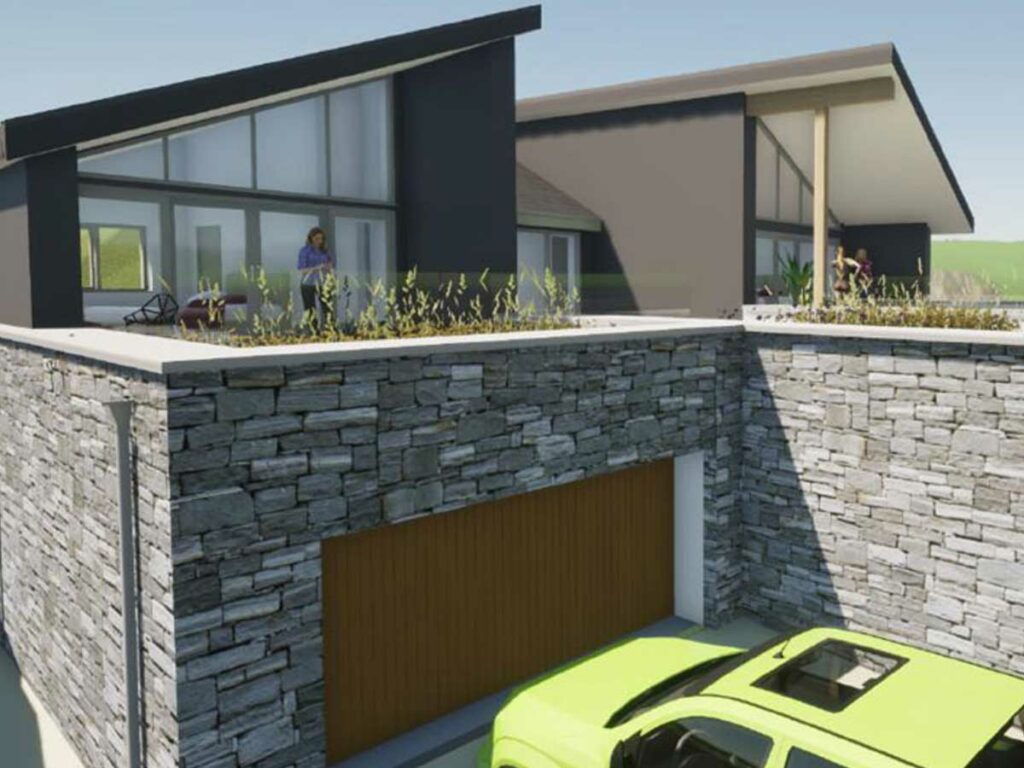
The Moorings passive house: a 250 m2 private home, in Anglesey, using MBC Timber Frame’s passive house system, and featuring the phA certified IZOPERM PLUS vapour control layer on the warm side of the roof insulation.
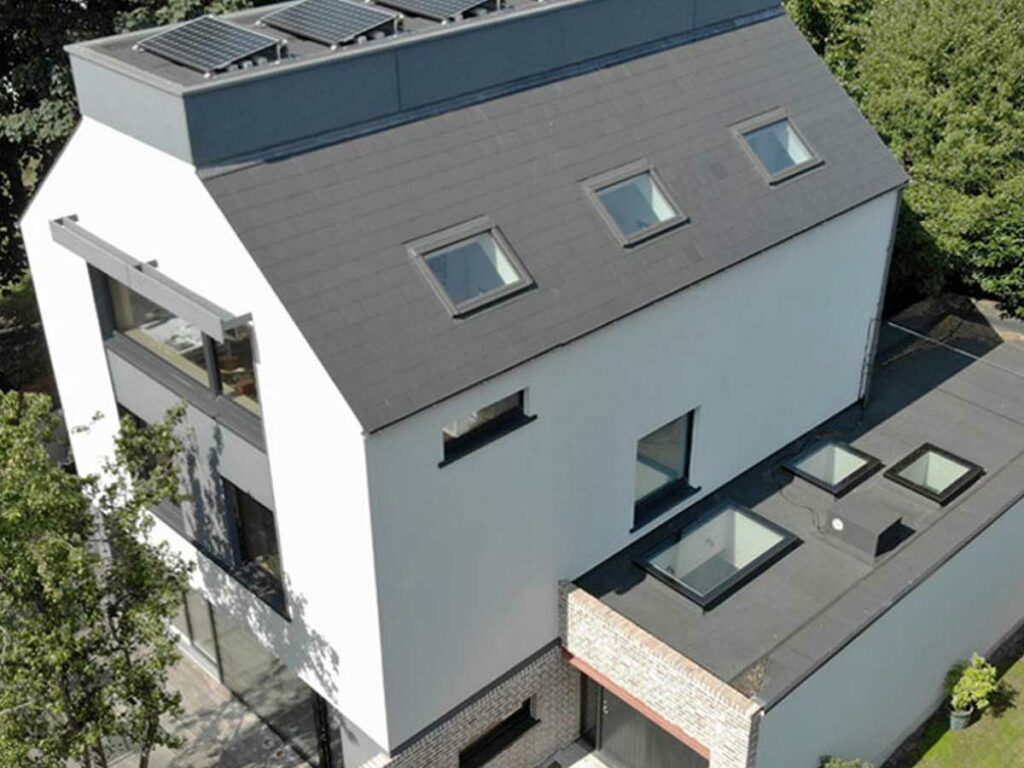
The Willows: certified Enerphit (passive house retrofit) upgrade of a detached home in south Dublin, with IZOPERM PLUS fitted behind joist ends, partition walls and service cavity battens, on the warm side of the roof insulation.
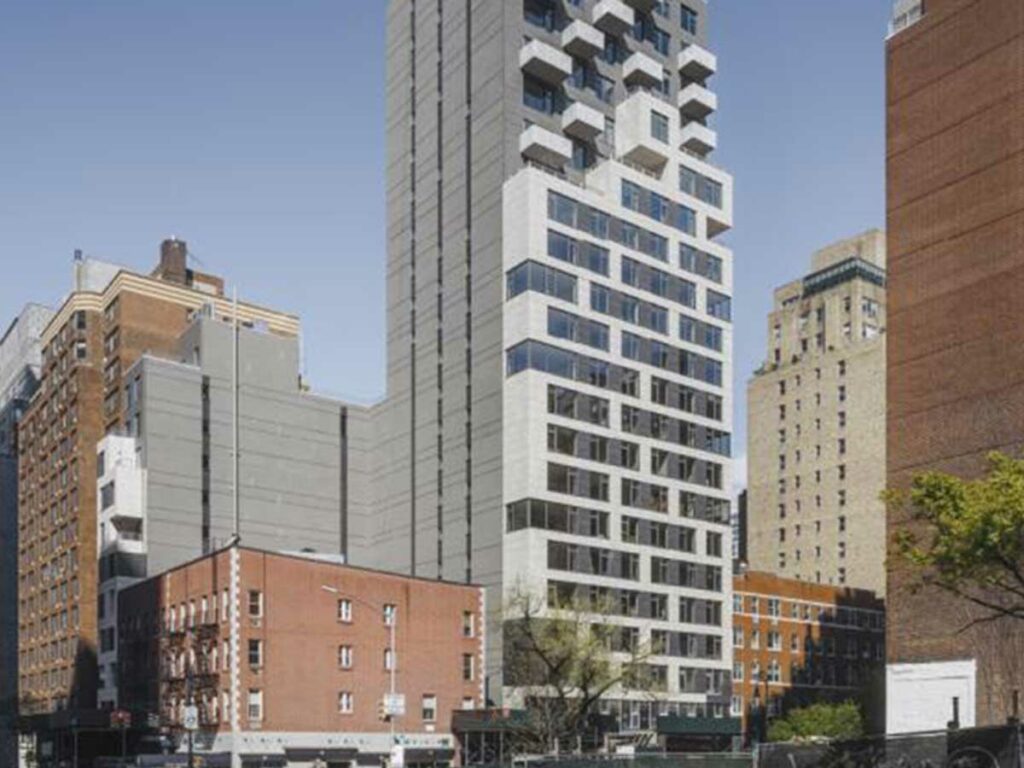
The Convivium, New York: a 22-storey passive-certified apartment building in New York, which employed the phA certified VARA FLUID liquid membrane on the inside face of the masonry construction to control moisture and block unwanted air infiltration.

